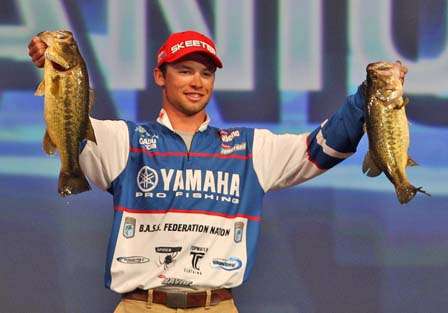
When he won the B.A.S.S. Federation Nation Championship on the Red River, Brandon Palaniuk relied on the same types of cover he fished on the rivers back home.
A rock jetty and backwater vegetation were the key targets for Palaniuk during the championship. Although the small rivers he fished in Idaho had neither jetties nor backwaters, the streams did have plenty of boulders and aquatic vegetation for Palaniuk to target during his formative years.
While growing up in Idaho, Palaniuk frequently fished a creek near his home and later gained experience fishing small rivers such as the upper section of the Snake River and tributaries that ran into Coeur d’Alene Lake.
“Most of our rivers that run into Coeur d’Alene are small and natural flowing,” he says.
Smaller streams have more natural current than the large rivers such as the Ohio or Mississippi where flows are altered by lock and dam systems. The smaller rivers also rise and fall faster after heavy rains. Palaniuk notes the Snake River could rise 10 feet while the Mississippi’s level could go up about 1 foot when each waterway receives the same amount of rainfall.
Smaller rivers lack backwaters, so bass live their entire lives on the main channel and constantly deal with current.
“I’ve seen smallmouth spawn behind a big boulder because that boulder creates enough of a current break where it can spawn,” says Palaniuk.
A bass’ hiding place is usually pretty easy to find on streams. “Typically with those smaller rivers, you have a lot faster moving current,” Palaniuk says, “so look for anything that the fish can get behind — a big boulder or big log — to wait and ambush bait as it comes by.”
Small lowland rivers frequently contain long stretches of grass or lily pads which make it more difficult for inexperienced anglers to pinpoint bass.
“Ninety percent of the time the fish will be in any spot where you can find something different in that stretch of grass or lily pads,” says Palaniuk. The Elite Series pro recommends keying on points or bends in the vegetation, brushpiles or logs mixed with the weeds or spots where the weeds are thicker or have a depth change.
Palaniuk’s lure and tackle selection for river fishing are similar to his choices for other waterways.
“You always hear about downsizing for smaller rivers, but I really think that’s only if it has smaller fish,” he says. “Just because it is a smaller river doesn’t mean it has smaller fish. If you look at a river like the Ohio, it has tiny fish whereas on a smaller river you can still be catching 3- and 4-pound fish.”
During spring, Palaniuk usually encounters murky to muddy water on streams due to rains or snow melt, so his first lure choice is a shallow- or medium-diving crankbait. He favors a crankbait because he believes it’s the most effective lure for running in the swift current.
His cranking tackle consists of a 7-foot medium action rod and Abu-Garcia Revo Premier 6.4:1 baitcast reel filled with 15-pound-test Berkley Trilene 100% Fluorocarbon. The Idaho angler believes the high-speed reel is a necessity for running a crankbait properly in the current.
“When you make a cast up past a rock and are bringing it down with that current, you have to be able to get that crankbait down and have to be able to take up line faster,” he says.
Soft plastics become Palaniuk’s pick when the flow slows down later in the spring. “Then I’ll pick up something like a Berkley Power Shaky Worm or a green pumpkin tube,” says Palaniuk, who opts for a 1/4-ounce shaky head jig and 1/4- or 3/8-ounce jig for his tube.
“The biggest thing is keeping contact with the bottom. You want to go with the lightest weight possible to give you the most natural presentation, but if you have more flow you’ll have to go to a heavier weight to keep it on the bottom.”
His soft plastics gear includes a 7-foot medium rod and spinning reel filled with 8-pound braid and an 8-pound fluorocarbon leader.
Editor’s Note: If you have a story idea you would like to vote on for an upcoming poll, send your idea to john@jnoutdoors.com.





